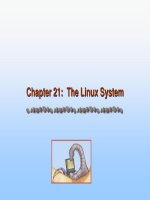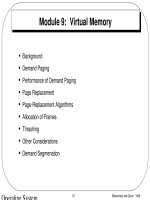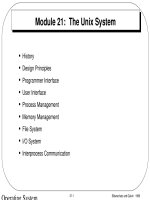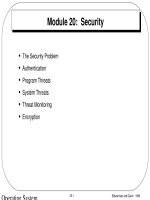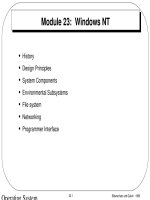Lecture Operating system concepts - Module 21
Bạn đang xem bản rút gọn của tài liệu. Xem và tải ngay bản đầy đủ của tài liệu tại đây (627.19 KB, 62 trang )
Module 21: The Unix System
•
•
•
•
•
•
•
•
•
History
Design Principles
Programmer Interface
User Interface
Process Management
Memory Management
File System
I/O System
Interprocess Communication
21.1
Silberschatz and Galvin 1999
History
•
First developed in 1969 by Ken Thompson and Dennis Ritchie of
the Research Group at Bell Laboratories; incorporated features of
other operating systems, especially MULTICS.
•
The third version was written in C, which was developed at Bell
Labs specifically to support UNIX.
•
The most influential of the non-Bell Labs and non-AT&T UNIX
development groups — University of California at Berkeley
(Berkeley Software Distributions).
– 4BSD UNIX resulted from DARPA funding to develop a
standard UNIX system for government use.
– Developed for the VAX, 4.3BSD is one of the most
influential versions, and has been ported to many other
platforms.
•
Several standardization projects seek to consolidate the variant
flavors of UNIX leading to one programming interface to UNIX.
21.2
Silberschatz and Galvin 1999
History of UNIX Versions
21.3
Silberschatz and Galvin 1999
Early Advantages of UNIX
•
•
•
Written in a high-level language.
•
Small size, modular, clean design.
Distributed in source form.
Provided powerful operating-system primitives on an
inexpensive platform.
21.4
Silberschatz and Galvin 1999
UNIX Design Principles
•
•
Designed to be a time-sharing system.
•
•
File system with multilevel tree-structured directories.
•
Supports multiple processes; a process can easily create new
processes.
•
High priority given to making system interactive, and providing
facilities for program development.
Has a simple standard user interface (shell) that can be
replaced.
Files are supported by the kernel as unstructured sequences of
bytes.
21.5
Silberschatz and Galvin 1999
Programmer Interface
Like most computer systems, UNIX consists of two separable parts:
•
Kernel: everything below the system-call interface and above the
physical hardware.
– Provides file system, CPU scheduling, memory
management, and other OS functions through system calls.
•
Systems programs: use the kernel-supported system calls to
provide useful functions, such as compilation and file
manipulation.
21.6
Silberschatz and Galvin 1999
4.3BSD Layer Structure
21.7
Silberschatz and Galvin 1999
System Calls
•
•
System calls define the programmer interface to UNIX
•
The programmer and user interface define the context that the
kernel must support.
•
Roughly three categories of system calls in UNIX.
– File manipulation (same system calls also support device
manipulation)
– Process control
– Information manipulation.
The set of systems programs commonly available defines the
user interface.
21.8
Silberschatz and Galvin 1999
File Manipulation
•
A file is a sequence of bytes; the kernel does not impose a
structure on files.
•
•
Files are organized in tree-structured directories.
•
Path name: identifies a file by specifying a path through the
directory structure to the file.
– Absolute path names start at root of file system
– Relative path names start at the current directory
•
System calls for basic file manipulation: create, open, read,
write, close, unlink, trunc.
Directories are files that contain information on how to find other
files.
21.9
Silberschatz and Galvin 1999
Typical UNIX directory structure
21.10
Silberschatz and Galvin 1999
Process Control
•
•
•
A process is a program in execution.
•
A zombie process results when the parent of a defunct child
process exits before the terminated child.
Processes are identified by their process identifier, an integer.
Process control system calls
– fork creates a new process
– execve is used after a fork to replace on of the two
processes’s virtual memory space with a new program
– exit terminates a process
– A parent may wait for a child process to terminate; wait
provides the process id of a terminated child so that the
parent can tell which child terminated.
– wait3 allows the parent to collect performance statistics
about the child
21.11
Silberschatz and Galvin 1999
Illustration of Process Control Calls
21.12
Silberschatz and Galvin 1999
Process Control (Cont.)
•
Processes communicate via pipes; queues of bytes between
two processes that are accessed by a file descriptor.
•
•
All user processes are descendants of one original process, init.
init forks a getty process: initializes terminal line parameters and
passes the user’s login name to login.
– login sets the numeric user identifier of the process to that
of the user
– executes a shell which forks subprocesses for user
commands.
21.13
Silberschatz and Galvin 1999
Process Control (Cont.)
•
setuid bit sets the effective user identifier of the process to the
user identifier of the owner of the file, and leaves the real user
identifier as it was.
•
setuid scheme allows certain processes to have more than
ordinary privileges while still being executable by ordinary
users.
21.14
Silberschatz and Galvin 1999
Signals
•
Facility for handling exceptional conditions similar to software
interrupts.
•
The interrupt signal, SIGINT, is used to stop a command before
that command completes (usually produced by ^C).
•
Signal use has expanded beyond dealing with exceptional
events.
– Start and stop subprocesses on demand
– SIGWINCH informs a process that the window in which
output is being displayed has changed size.
– Deliver urgent data from network connections.
21.15
Silberschatz and Galvin 1999
Process Groups
•
Set of related processes that cooperate to accomplish a
common task.
•
Only one process group may use a terminal device for I/O at
any time.
– The foreground job has the attention of the user on the
terminal.
– Background jobs – nonattached jobs that perform their
function without user interaction.
•
Access to the terminal is controlled by process group signals.
21.16
Silberschatz and Galvin 1999
Process Groups (Cont.)
•
Each job inherits a controlling terminal from its parent.
– If the process group of the controlling terminal matches the
group of a process, that process is in the foreground.
– SIGTTIN or SIGTTOU freezes a background process that
attempts to perform I/O; if the user foregrounds that
process, SIGCONT indicates that the process can now
perform I/O.
– SIGSTOP freezes a foreground process.
21.17
Silberschatz and Galvin 1999
Information Manipulation
•
System calls to set and return an interval timer:
getitmer/setitmer.
•
Calls to set and return the current time:
gettimeofday/settimeofday.
•
Processes can ask for
– their process identifier: getpid
– their group identifier: getgid
– the name of the machine on which they are executing:
gethostname
21.18
Silberschatz and Galvin 1999
Library Routines
•
The system-call interface to UNIX is supported and augmented
by a large collection of library routines
•
Header files provide the definition of complex data structures
used in system calls.
•
Additional library support is provided for mathematical functions,
network access, data conversion, etc.
21.19
Silberschatz and Galvin 1999
User Interface
•
Programmers and users mainly deal with already existing
systems programs: the needed system calls are embedded
within the program and do not need to be obvious to the user.
•
The most common systems programs are file or directory
oriented.
– Directory: mkdir, rmdir, cd, pwd
– File: ls, cp, mv, rm
•
Other programs relate to editors (e.g., emacs, vi) text formatters
(e.g., troff, TEX), and other activities.
21.20
Silberschatz and Galvin 1999
Shells and Commands
•
Shell – the user process which executes programs (also called
command interpreter).
•
•
Called a shell, because it surrounds the kernel.
•
•
A typical command is an executable binary object file.
•
The directories /bin and /usr/bin are almost always in the search
path.
The shell indicates its readiness to accept another command by
typing a prompt, and the user types a command on a single
line.
The shell travels through the search path to find the command
file, which is then loaded and executed.
21.21
Silberschatz and Galvin 1999
Shells and Commands (Cont.)
•
Typical search path on a BSD system:
( ./home/prof/avi/bin /usr/local/bin /usr/ucb/bin/usr/bin )
•
The shell usually suspends its own execution until the
command completes.
21.22
Silberschatz and Galvin 1999
Standard I/O
•
Most processes expect three file descriptors to be open when
they start:
– standard input – program can read what the user types
– standard output – program can send output to user’s
screen
– standard error – error output
•
Most programs can also accept a file (rather than a terminal) for
standard input and standard output.
•
The common shells have a simple syntax for changing what
files are open for the standard I/O streams of a process — I/O
redirection.
21.23
Silberschatz and Galvin 1999
Standard I/O Redirection
Command
Meaning of command
% ls > filea
direct output of ls to file filea
% pr < filea > fileb
input from filea and output to fileb
% lpr < fileb
input from fileb
%% make program > & errs
save both standard output and
standard error in a file
21.24
Silberschatz and Galvin 1999
Pipelines, Filters, and Shell Scripts
•
Can coalesce individual commands via a vertical bar that tells
the shell to pass the previous command’s output as input to the
following command
% ls | pr | lpr
•
Filter – a command such as pr that passes its standard input to
its standard output, performing some processing on it.
•
Writing a new shell with a different syntax and semantics would
change the user view, but not change the kernel or programmer
interface.
•
X Window System is a widely accepted iconic interface for
UNIX.
21.25
Silberschatz and Galvin 1999
